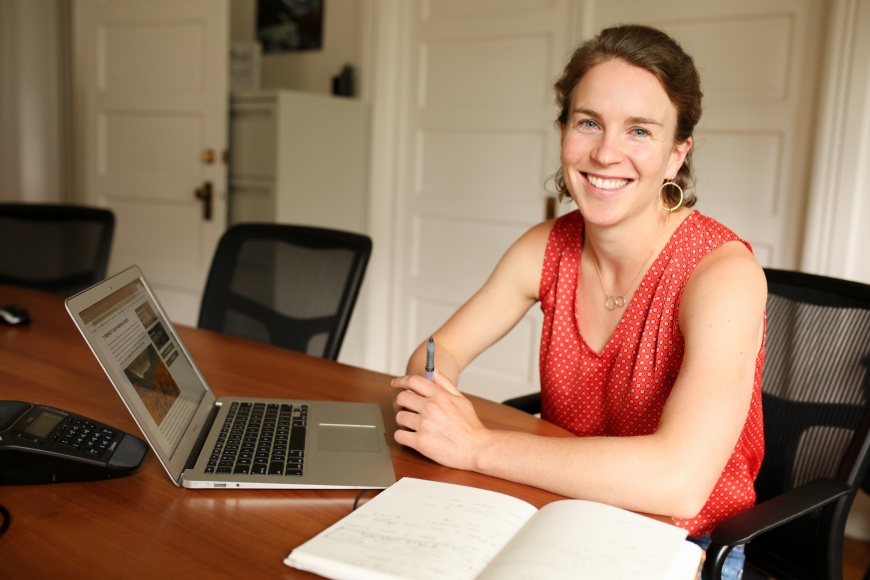
 back to all alumni stories
back to all alumni stories
Emily Blackmer (MS ’20)

Policy Analyst
Sierra Nevada Conservancy
Auburn, California
What did it mean to you to be named a Wyss Scholar? What were some of the activities and opportunities that held the greatest impact for you?
Being named a Wyss Scholar was a cornerstone of my experience at SEAS. As someone who was pivoting my career into Western conservation, the vote of confidence from the Wyss committee meant a lot. It helped me believe that I could end up where I wanted to be, and it helped me structure my academic experience at SEAS to acquire the knowledge and skills that would serve me well in a conservation career. In terms of impact, the Wyss network—both at U-M and beyond—is very strong, and its specificity to Western conservation is really valuable. I should also mention that financial support from Wyss has made a significant difference in pursuing this career path.
Can you tell us about your SEAS experience? How did it help you advance in the conservation field?
Two key components of my SEAS experience helped jump-start my conservation career. First and foremost was the guidance of my advisers, Steve Yaffee and Julia Wondolleck, who helped me identify the skills I would need and the opportunities to develop them, from courses to internships to my capstone. This was especially true for my master’s project, co-advised by Steve and Julia. That project helped me get my current job, and I use what I learned in my master’s project on a daily basis. The second was the general flexibility of the SEAS curriculum and U-M. Being able to take courses in a range of disciplines and schools—especially ecology courses and courses at the Law School—was a huge plus and helped build another set of skills that I rely on.
What kind of changes have you observed in land conservation in the U.S. in recent years?
I work in the Sierra Nevada region of California, which is the highest fire-risk region of the most fire-prone state. In recent years, we have experienced extremely large, catastrophic wildfires that are well beyond anything we’d expect based on historical reference conditions. We’re talking about multiple fires a year in which tens of thousands of mostly contiguous acres of forest burn at such high intensity that greater than 75% of above ground biomass is killed. These wildfires are the result of 100+ years of forest management practices that suppressed almost all natural and cultural fire and reduced forest resilience via intensive logging. Add stressors like climate change, drought and disease (which have caused an ongoing mass tree mortality event) into the mix, and our forests are primed to burn. It’s a matter of when, not if.
In these circumstances, the entire framework that conservation has relied on is turned on its head. Setting land aside and leaving it alone isn’t going to address our ecological problems if the whole forest turns into black sticks within a decade or so. That doesn’t protect wildlife habitat and it doesn’t preserve our forest carbon stores, especially because climate change increases the likelihood of type conversion—of chaparral growing back instead of trees. In this situation, conservation and restoration are two sides of the same coin: we need management—in the form of ecological forest restoration, and especially the return of low- to moderate-severity fire—to accomplish our conservation goals. But this kind of paradigm shift comes with lots of thorny questions. How do we address trade-offs between short-term risks to sensitive species from restoration versus long-term risks from catastrophic wildfire? How do we choose what areas and what values to protect via restoration, accepting that we don’t have the resources to do everything? What might be the unintended consequences of our restoration efforts?
To me, these questions really exemplify the challenge of making social-ecological decisions in an era of rapid ecological and climate change. We are faced with so many trade-offs, and there is so much uncertainty about the outcomes of those trade-offs. It can feel paralyzing. But I am encouraged by the fact that there’s an incredibly strong scientific consensus that forest restoration, especially with so-called “good fire,” can meaningfully reduce the risk of catastrophic fire. There are so many passionate people working on this issue. And in the last year we have seen significant investments in forest restoration by both California and the federal government. So, I’m hopeful that this trend will continue.

